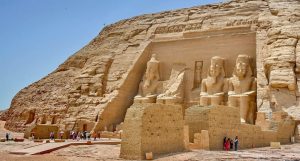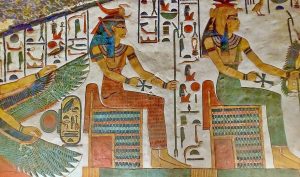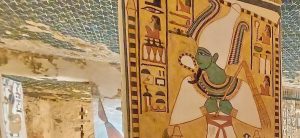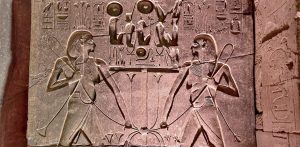Architecture is the most renowned and well-known component of ancient Egyptian culture. The ancient Egyptian architecture conveys the history of the Egyptians and demonstrates their strong bond with their lands and gods.
The fundamental ideas of theocracy, which saw the Pharaoh as a divinity, the idea of an eternal afterlife, and the representation of their religious philosophy and belief system, drove the Egyptian people. These ideas gave rise to ancient Egyptian civilization and affected ancient Egyptian architecture.
Ancient Egyptian Architecture History
Because the history of ancient architecture predates 3100 BC, historians split its growth and transition into historical periods and stages: The notion of architecture was originally studied throughout the predynastic and early dynasty periods.
The obelisks are enormous stone monuments with four sides and a tapering top that represent the interaction between the gods and the people, and they were raised in pairs. Quarrying, cutting, transporting, and a large workforce were all required for the construction of the obelisks.
Egypt was prepared to transform the face of architecture by constructing the pyramids since it had mastered these techniques. Many significant events occurred in 3100 BC, including Egypt’s unification, the widespread use of hieroglyphic writing, and the construction of the Mastabas, a one-story brick box containing burial tombs that was used in the 2630 BC.
It embodied the magnificent aspects of symmetry, proportion, and majesty that are fundamental to ancient Egyptian civilization. The step pyramids demonstrate how far the Egyptians had progressed in their grasp of architectural design and construction, serving as a vital connection between the pyramid’s past and future.
Because of the number of pyramids built during the Old Kingdom of Egypt (2686-2181 BC), this time was dubbed the “Golden Age of Architecture.” Because of Imhotep’s inventions, a wave of Pyramid building swept the region.
The 4th dynasty’s King Sneferu (2613-2589) built the first pyramid of Meidum, ushering in the old kingdom’s golden period.
His son and successor, Pharaoh Khufu (2589-2566 BC), carried on his father’s legacy by directing his administration in the construction of the Great Pyramid of Giza, the last intact seven wonders of the ancient world, which was erected by hired laborers to be the ultimate resting place of the pharaohs.
The builders of the old empire built smooth-sided pyramids of limestone that aligned with the sun, making it easier for the pharaoh’s soul to ascend to the skies and take their due position among the gods. The art of building achieved a pinnacle at Giza, Dahshur, and Saqqara with the construction of the pyramid, the inside of which was covered with sculptures, statues, and paintings showcasing the splendor of ancient Egyptian art.
Due to the control of the monarchs and the priests, there was a cultural shift in Egypt’s Middle Kingdom (2055-1650 BC) that resulted in the decline of artworks and the architecture of the pyramids in both size and quality and the rise of enchanting chapels, rock-carved tombs, decorative columns, and painted walls. This age best exemplifies the brightness and elegance of ancient Egyptian architecture, and the style mirrored the cosmos and the start of creation by Atum.
The New Kingdom of Egypt (1550-1070 BC) was dominated by the construction of temples, rock-cut tombs, and wall reliefs. The most renowned architectural accomplishments were built in the new monarchy, including Hatshepsut Temple, Luxor Temple, Karnak Temple, Abu Simbel, and the Valley of the Kings.
The enormous stone temples devoted to ancient Egypt’s many gods were among the most famous architectural achievements of this era. A massive entryway, a colonnaded courtyard, a hall of columns, and a shrine chamber were all part of the design. The new architectural design of columns, pillars, and capitals, as well as the mural painting, were based on plant themes.
Ptolemaic Period (332 -30 BC) After the city of Alexandria was created and aesthetically planned to represent the magnificent majesty of the Greek kingdom in 331 BC, the Greek dynasty took the position of pharaohs. During this time, the Greek influence began to appear in ancient Egyptian designs, as seen in the Philae and Edfu temples, when they adopted old Egyptian beliefs.
The Romans continued this trend by adding their own building methods and materials. These monuments have continued to fascinate visitors from all over the world, defying the passage of time and the traditional idea of architecture.
Interesting Ancient Egyptian Architecture Fact
The ancient Egyptian culture and value system had a significant role in highlighting the symmetry of the buildings, interior architecture, and inscriptions.
And with their incredible architectural designs, building materials, and massive labor farce, they were able to immortalize structures like the Giza pyramids and Sphinx, which became the most recognizable symbols of ancient Egypt, and to honor the gods like Osiris, Isis, Horus, Ra, and countless others, various great temples were built in the great cities of Luxor and Aswan, which manifest the beautiful spirit of ancient Egyptian art.
The ancient Egyptian religion, notably the myth of creation, which claims that Atum built the cosmos from his primordial mound at the beginning of time, influenced the shape, design, and function of these buildings. Because there was no term for “architect” in ancient Egypt, each master-builder was recognized as “director of the entire king’s works,” indicating that they had a particular position of trust with the monarch and frequently functioned as his vizier.
Ancient Egyptian Architecture Characteristics
Due to a shortage of wood, the ancient Egyptians used stone to build their structures, particularly limestone, granite, and sandstone, which was balanced by an abundance of sun-baked mud bricks, which were the primary material of construction in the early dynasties.
These mud-brick and stone structures were employed to create everything from royal palaces to fortified buildings, outbuildings, temple walls, and numerous other structures until the development of stone architecture in the 2nd dynasty (2890-2670 BC). Before the invention of bricks, these early structures were round, but afterward, they became rectangular with a vaulted ceiling, a garden, and a courtyard.
Most structures, including temples and pyramids, were erected along the Nile Water because building supplies were carried by river, and they had a flat roof supported by exterior walls and columns adorned with mystical Hieroglyphs for the purpose of protection or documenting historical events.
As civilization progressed, the society banded together for safety, giving rise to cities such as Memphis and Thebes, which took the art of building to new heights, as well as the emergence of windows and doors.
The traditional Egyptian houses were built with mud bricks and timber, with occasional stone rests for thresholds or column bases, and the nobles’ palaces were built with two entrances, two receiving halls, and two throne rooms to maintain symmetry and balance while representing both upper and lower in the design.
Ancient Egyptian Architecture Examples
The Great Pyramid of Giza, also known as the Pyramid of Khufu and the “Pyramid of Cheops,” the Great Sphinx of Giza (The Terrifying One or the Sole Protector of Egypt), and the Step Pyramid of Djoser in Saqqara are the three most popular monuments of ancient Egypt.
In the magnificent towns of Luxor and Aswan, there are numerous amazing constructions that really represent the beauty and brilliance:
- The Luxor Temple is a massive religious complex founded in 1400 BCE for the Opet festival.
- The beautiful Temple of Hatshepsut is a mortuary temple designed in the 15th century BCE by the queen’s architect Senenmut to reflect the form of classical architecture.
- The Valley of the Kings contains more than 60 known tombs of kings and queens from various dynasties and is highly famous for its incredible hypnotic decoration and marvelous design. It contains numerous portions that have been destroyed and restored throughout the years.
- Abu Simbel, Egypt’s ultimate frontier in the south and the commander of marvels, is the site of two magnificent temples, one dedicated to Nefertari and the other to Ramses the Great.
Explore Ancient Egyptian Architecture Yourself
There is no greater site on Earth to represent the real essence of ancient architecture than Egypt’s enthralling monuments. Don’t pass up the opportunity to see the country of wonder and beauty by booking one of our Egypt holiday packages or sailing on the sacred spirit of the past on a Nile river cruise.
Useful links:
- civilization of ancient Egypt
- deluxe tours
- egypt unesco tours
- Best Tourist Attractions
- Explore Egypt Destinations






